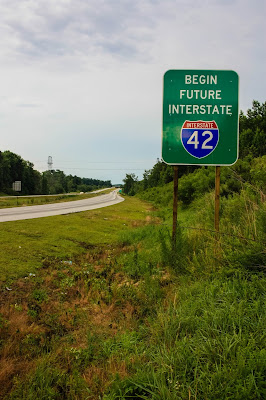It hasn't taken North Carolina long to start putting up signs announcing the new Interstate Highways Corridors in the Eastern half of the state. Future Interstate 42 signs are already up along US 70 from Clayton to New Bern. Two weeks ago, I grabbed this shot on US 70 East at the start of the Clayton Bypass once you get on the highway from Interstate 40.
Signs for Future Interstate 87 aren't just ready yet. For the past three weeks - these sign posts stand tall and alone on US 64 just east of Interstate 95 in Rocky Mount.
Now, this delay may be because NCDOT is wanting to erect the new signs and update the Future Interstate 495 signs at the same time; or who knows maybe a write-in campaign to protest the I-87 designation to the FHWA worked!



Comments